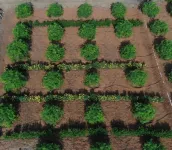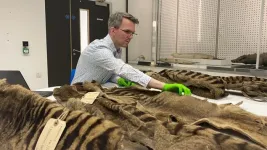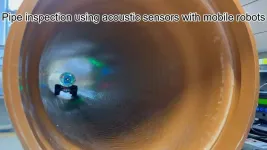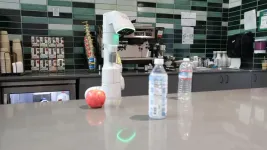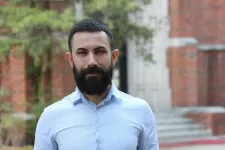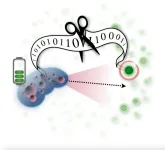(Press-News.org) The costs of environmental pollution caused by plastics in cigarette butts and packaging amount to an estimated US$26 billion every year or US$186 billion every 10 years—adjusted for inflation—in waste management and marine ecosystem damage worldwide, finds a data analysis published online in the journal Tobacco Control.
These costs may seem small compared with the overall economic and human toll of tobacco, but they are cumulative and preventable, highlights the researcher.
And although great strides have been made in developing policies to curb or ban single use plastics around the globe, tobacco’s plastic has been overlooked, she adds.
This is despite the fact that cigarette filters—the main component of cigarette butts—are the most common item of rubbish collected on the planet. And they are made of single use plastic.
To try and gauge the global economic toll of tobacco products’ toxic waste, and better inform tobacco control and environmental protection agencies, the researcher drew on currently available public data sources for cigarette sales, clean-up costs, and plastic waste on land and sea.
These sources included the World Bank, the Organization for Economic Cooperation and Development (OECD),The Tobacco Atlas, and the World Wildlife Fund.
The average weight of each plastic filter is 3.4g. As cigarette butts are often littered along with plastic packaging, which weighs an average 19g for a standard pack size of 20 cigarettes, this was also included in the calculations.
The researcher estimated the annual and 10-year projections of the environmental and economic costs of tobacco plastic based on the tonnage. Ten-year projections were included because cigarette butts are reported to take 10 years to degrade.
The total figure reflects cost estimates of clean-up and disposal (adjusted for inflation) of the total plastic generated by filtered cigarette sales potentially ending up as waste in the sea, landfills, or in the environment.
The researchers estimated that the annual economic cost of cigarette plastics waste is around US$26 billion, made up of US$20.7 billion in marine ecosystem damage and US$5 billion in waste management costs, adding up to US$186 billion over 10 years.
“Although this amount is small compared with the annual economic losses from tobacco (US$1.4 trillion per year) and may appear insignificant compared with the 8 million deaths attributable to tobacco each year, these environmental costs should not be downplayed as these are accumulating and are preventable,” emphasises the researcher.
Countries with the highest number of cigarette butts are mostly low and middle income countries–the same countries where the ‘leakage’ rate for plastics into the environment, thought to be between 1% and14%, is likely higher, she adds.
The costs of tobacco product plastic pollution are likely highest in China, Indonesia, Japan, Bangladesh and the Philippines, the estimates suggest.
The researcher acknowledges that the figures are only estimates, but they are likely to be conservative, she says, because they don’t account for the toxic metals and chemicals in cigarette butts that accrue over time, making them more harmful than general plastic waste.
“Cigarette filters have been polluting our oceans and land for at least five decades, and these trash items may have a carrier effect with the toxic chemicals leached from them. Human and ecosystem impacts of this toxic chemical accumulation are unknown,” she writes.
“The general estimates provided here could provide fiscal evidence of the need to mitigate tobacco plastic waste pollution,” and the data could help “in assigning industry responsibility for these losses, including that of the [tobacco industry],” she suggests.
Policies to shift the responsibility for the clean-up costs to the tobacco industry are under consideration in France, the UK, the European Union and the USA, she adds.
END
Plastic pollution from cigarette butts likely costs US$26 billion/year or US$186 billion over 10 years
Relatively small compared with overall toll of tobacco, but costs cumulative and preventable. Bans on single use plastics increasingly common, but tobacco sources overlooked
2023-11-29
ELSE PRESS RELEASES FROM THIS DATE:
Faster walking speed of 4 km+/hour linked to significantly lower type 2 diabetes risk
2023-11-29
Walking at a speed of 4 or more km an hour is linked to a significantly lower risk of type 2 diabetes, suggests a pooled data analysis of the available evidence, published online in the British Journal of Sports Medicine.
And the faster the speed above 4 km/hour, the lower the risk seems to be, with every 1 km increase in speed associated with a 9% reduction in risk, the findings suggest.
While regularly nipping out for a stroll is associated with a lower risk of developing type 2 diabetes, it’s not clear what the optimal speed might be to ward off the disease, ...
Five-fold rise in UK rates of transgender identity since 2000, medical records suggest
2023-11-29
UK rates of transgender identity have risen 5-fold since 2000, with the highest rise observed among 16 to 29 year olds, although the overall numbers are still small, suggests an analysis of nearly 20 years of anonymised general practice records, published online in the open access journal BMJ Medicine.
And rates of people identifying as transgender were more than twice as high in the most socially and economically deprived areas as they were in less deprived areas, the analysis shows.
A solid grasp of the numbers and ages of those identifying as transgender is essential ...
6+ hours/day of sedentary leisure time linked to doubling in fibroids risk
2023-11-29
Clocking up 6 or more hours of sedentary leisure time every day may double a woman’s risk of uterine fibroids before she’s gone through the menopause, suggests research published in the open access journal BMJ Open.
The risk of these benign, but potentially large and painful, womb growths seems to rise in tandem with the amount of time spent sitting or lying down during the day, the findings suggest.
Uterine fibroids are the most common benign tumours in women of childbearing age, varying in prevalence from 4.5% to 69%, say the researchers.
These growths may not produce any symptoms, but they may also be associated with abnormal bleeding, pelvic and abdominal pain, ...
Increase in the number of people identifying as transgender in the UK
2023-11-29
The number of people identifying as transgender in their GP records in the UK has increased between 2000 and 2018, finds a new study led by UCL researchers.
The research, published in BMJ Medicine, is the first large-scale study in the UK to estimate the number of people whose gender identity is different to their sex assigned at birth.
To do this, the team reviewed anonymised data from 7 million individuals aged 10 to 99 years, from IQVIA Medical Research Data, a UK primary care database, between 2000 and 2018.
Researchers looked for diagnostic codes that suggested patients had spoken to their GP about ...
Flower power on Indian farms helps bees and boosts livelihoods
2023-11-29
Planting flowers beside food crops on farms in India attracts bees, boosts pollination and improves crop yield and quality, researchers have found.
The research, the first Indian study of its kind, is published today (Monday, 28 November) in the Journal of Applied Ecology and was carried out in South India by ecologists from the University of Reading, UK, and the M S Swaminathan Research Foundation, India.
The scientists focused on the Moringa crop, a nutrient-rich "superfood," and its essential pollinators – bees.
By planting companion marigold flowers and ...
Historical violence in Tasmania: Victorian collector traded human Aboriginal remains for scientific accolades, study reveals
2023-11-29
A Hobart-based solicitor built his reputation as “the foremost scientist in the colony” in the mid-1800’s, despite limited contributions to scientific knowledge.
Morton Allport achieved his status by obtaining the bodily remains of Tasmanian Aboriginal people and Tasmanian tigers, also known as thylacines, and sending them to collectors in Europe – specifically asking for scientific accolades in return.
This took place in the context of a genocide against the Tasmanian Aboriginal peoples, and persecution of the thylacine that eventually led to its extinction.
The new research by Jack Ashby, Assistant Director of the University Museum of Zoology, Cambridge, ...
Network of robots can successfully monitor pipes using acoustic wave sensors
2023-11-29
An inspection design method and procedure by which mobile robots can inspect large pipe structures has been demonstrated with the successful inspection of multiple defects on a three-meter long steel pipe using guided acoustic wave sensors.
The University of Bristol team, led by Professor Bruce Drinkwater and Professor Anthony Croxford, developed approach was used to review a long steel pipe with multiple defects, including circular holes with different sizes, a crack-like defect and pits, through a designed inspection path to achieve 100% detection coverage for a defined reference defect.
In the study, published today in NDT and E International, ...
How do you make a robot smarter? Program it to know what it doesn’t know
2023-11-29
Modern robots know how to sense their environment and respond to language, but what they don’t know is often more important than what they do know. Teaching robots to ask for help is key to making them safer and more efficient.
Engineers at Princeton University and Google have come up with a new way to teach robots to know when they don’t know. The technique involves quantifying the fuzziness of human language and using that measurement to tell robots when to ask for further directions. Telling a robot to pick ...
Researchers working to develop next-generation polymer membranes for sustainable materials science
2023-11-28
Michele Galizia, a President’s Associates Presidential Professor in the School of Sustainable Chemical, Biological and Materials Engineering at the University of Oklahoma, is leading a research team that recently received a grant from the U.S. Department of Energy that will develop improved polymer membranes to advance molecular separation and related materials science.
“We currently separate chemicals, gases and liquids using a thermal-based distillation technology that is very expensive to operate and consumes the equivalent of eight GJ of electricity per person on the planet per year,” ...
Researchers have applied the theory of semantic information to a realistic model capturing attributes of living systems—and found the critical point where information matters for survival
2023-11-28
Living systems—unlike non-living or inanimate objects—use information about their surrounding environment to survive. But not all information from the environment is meaningful or relevant for survival. The subset of information that is meaningful, and perhaps necessary for being alive, is called semantic information.
In a new paper published in PRX Life, University of Rochester physicists and their coauthors have, for the first time, applied this theory of semantic information to a well-known ...
LAST 30 PRESS RELEASES:
Making lighter work of calculating fluid and heat flow
Normalizing blood sugar can halve heart attack risk
Lowering blood sugar cuts heart attack risk in people with prediabetes
Study links genetic variants to risk of blinding eye disease in premature infants
Non-opioid ‘pain sponge’ therapy halts cartilage degeneration and relieves chronic pain
AI can pick up cultural values by mimicking how kids learn
China’s ecological redlines offer fast track to 30 x 30 global conservation goal
Invisible indoor threats: emerging household contaminants and their growing risks to human health
Adding antibody treatment to chemo boosts outcomes for children with rare cancer
Germline pathogenic variants among women without a history of breast cancer
Tanning beds triple melanoma risk, potentially causing broad DNA damage
Unique bond identified as key to viral infection speed
Indoor tanning makes youthful skin much older on a genetic level
Mouse model sheds new light on the causes and potential solutions to human GI problems linked to muscular dystrophy
The Journal of Nuclear Medicine ahead-of-print tip sheet: December 12, 2025
Smarter tools for peering into the microscopic world
Applications open for funding to conduct research in the Kinsey Institute archives
Global measure underestimates the severity of food insecurity
Child survivors of critical illness are missing out on timely follow up care
Risk-based vs annual breast cancer screening / the WISDOM randomized clinical trial
University of Toronto launches Electric Vehicle Innovation Ontario to accelerate advanced EV technologies and build Canada’s innovation advantage
Early relapse predicts poor outcomes in aggressive blood cancer
American College of Lifestyle Medicine applauds two CMS models aligned with lifestyle medicine practice and reimbursement
Clinical trial finds cannabis use not a barrier to quitting nicotine vaping
Supplemental nutrition assistance program policies and food insecurity
Switching immune cells to “night mode” could limit damage after a heart attack, study suggests
URI-based Global RIghts Project report spotlights continued troubling trends in worldwide inhumane treatment
Neutrophils are less aggressive at night, explaining why nighttime heart attacks cause less damage than daytime events
Menopausal hormone therapy may not pose breast cancer risk for women with BRCA mutations
Mobile health tool may improve quality of life for adolescent and young adult breast cancer survivors
[Press-News.org] Plastic pollution from cigarette butts likely costs US$26 billion/year or US$186 billion over 10 yearsRelatively small compared with overall toll of tobacco, but costs cumulative and preventable. Bans on single use plastics increasingly common, but tobacco sources overlooked
